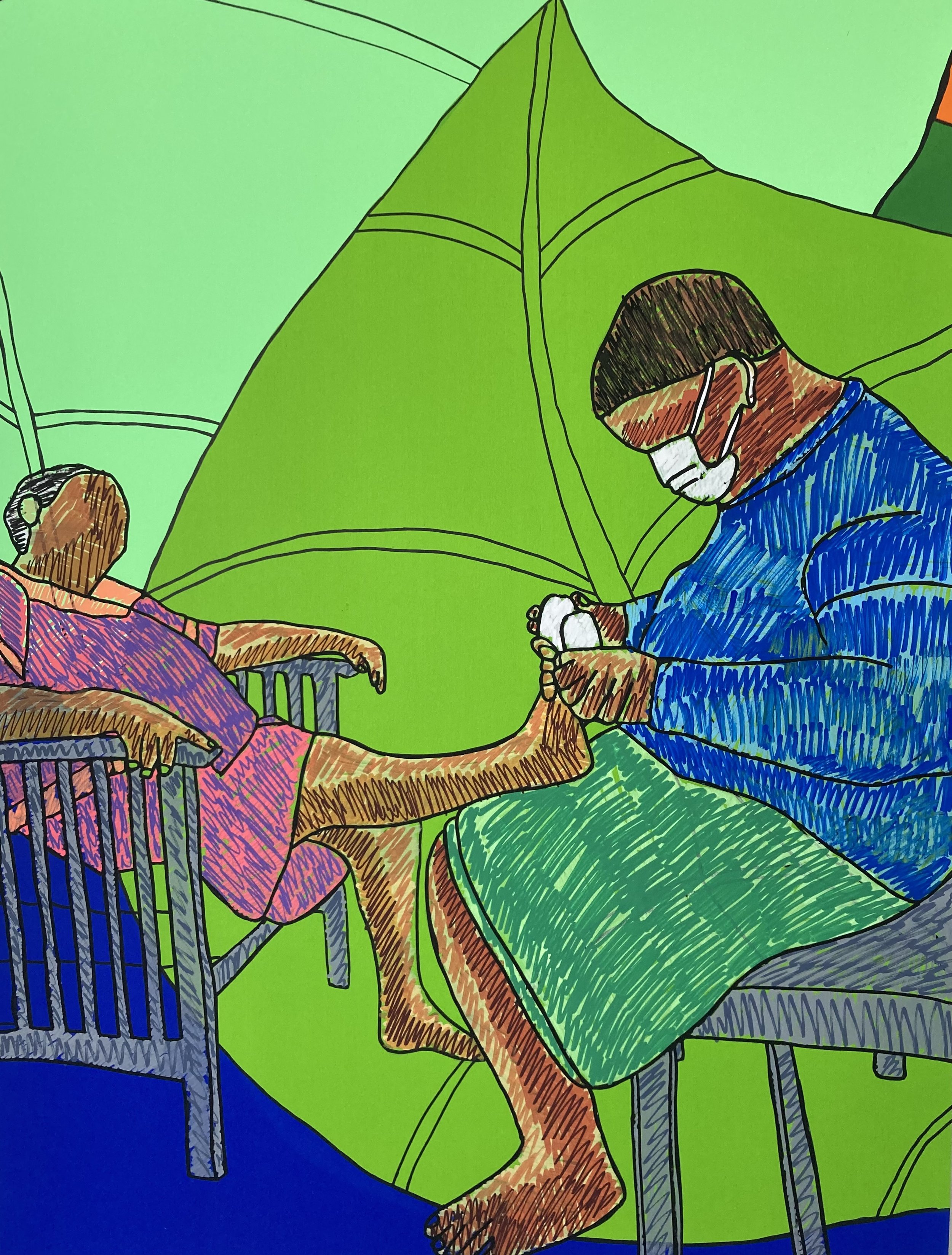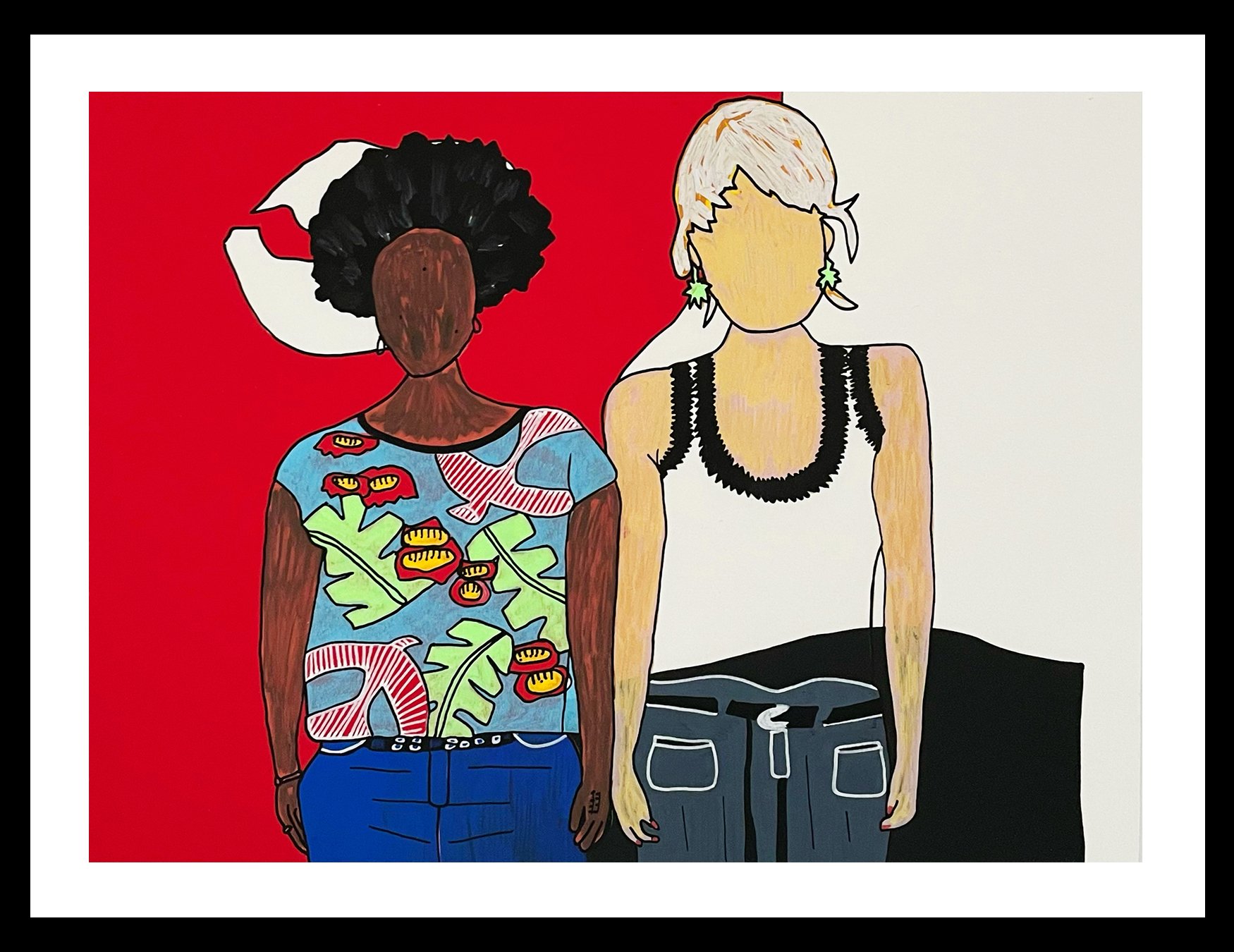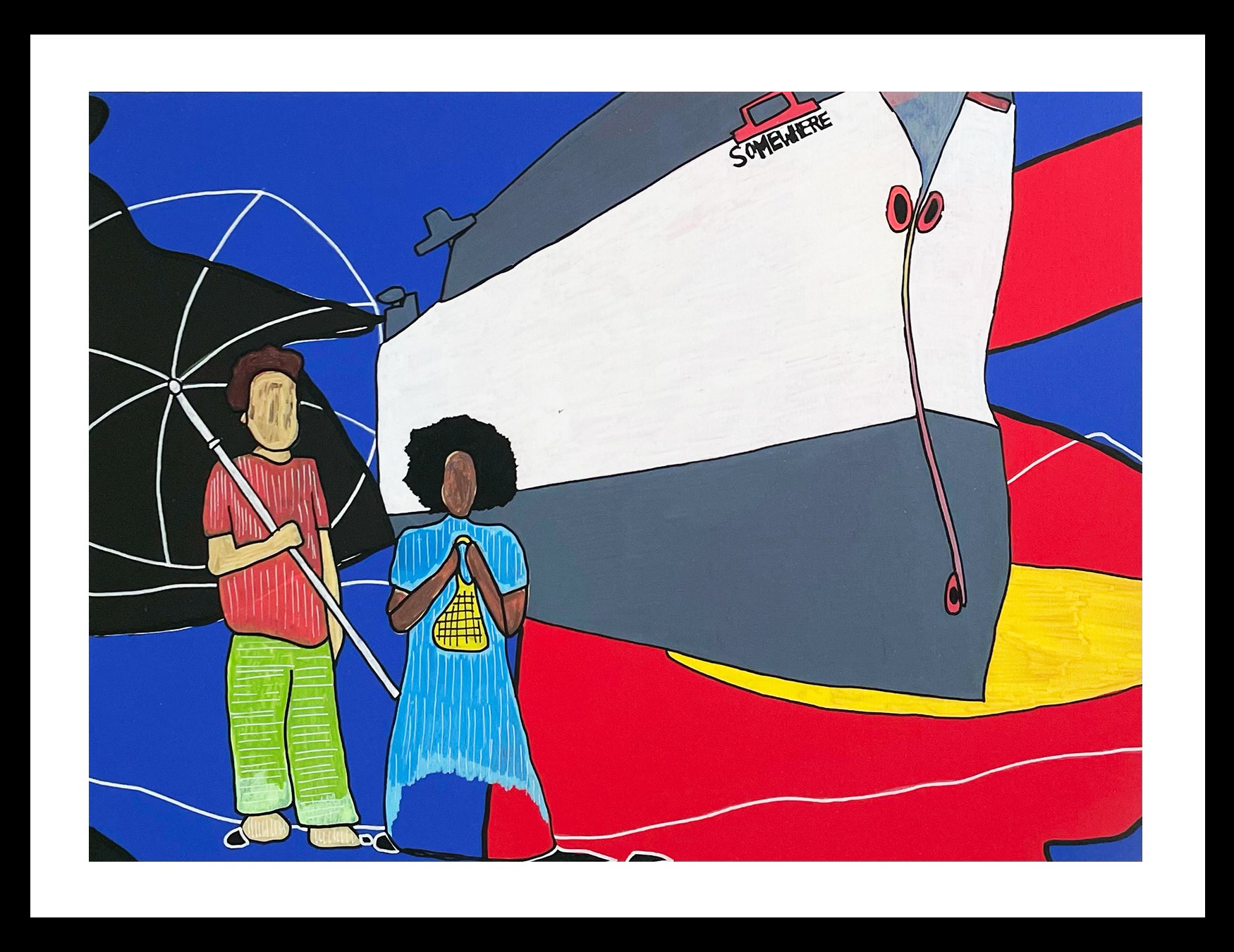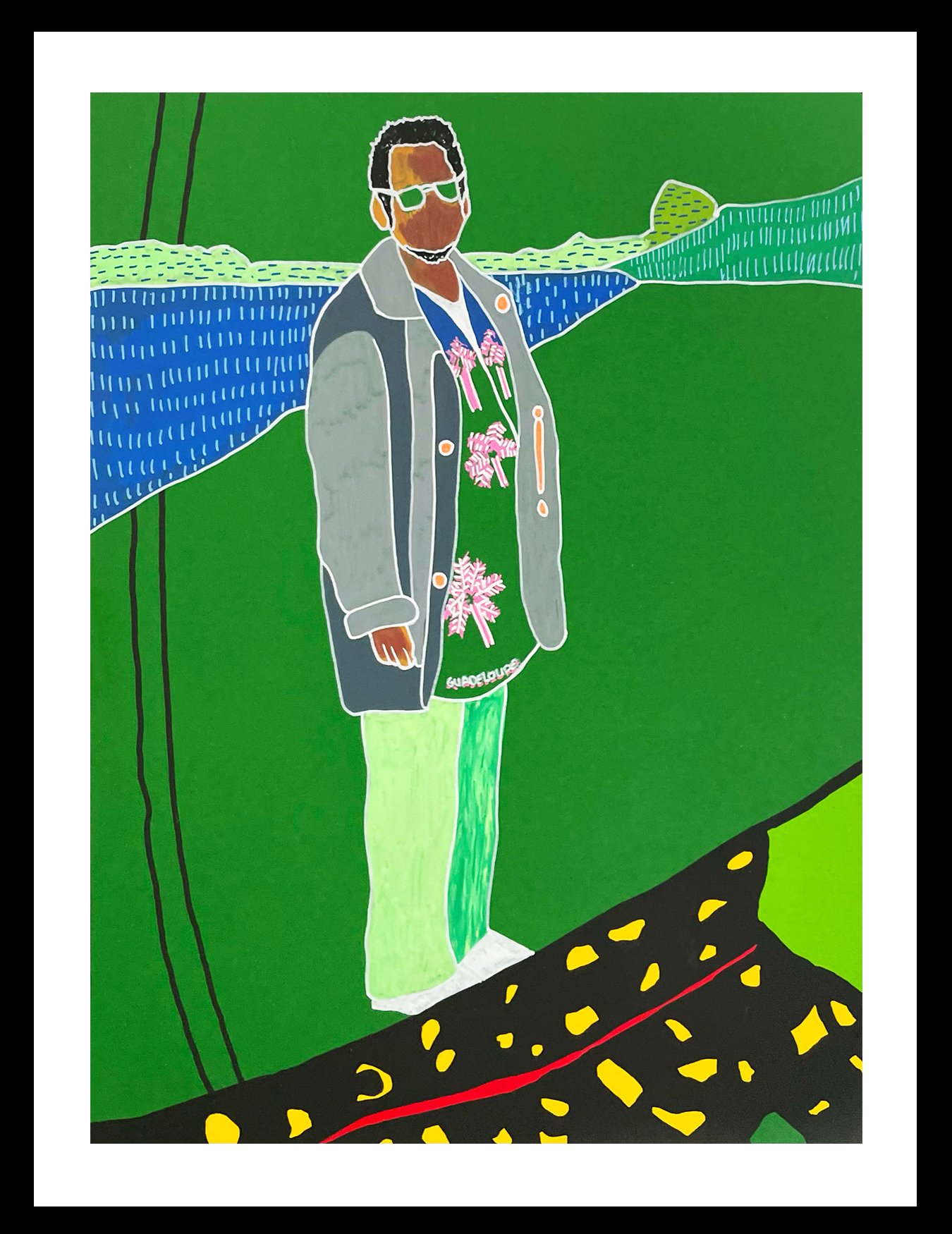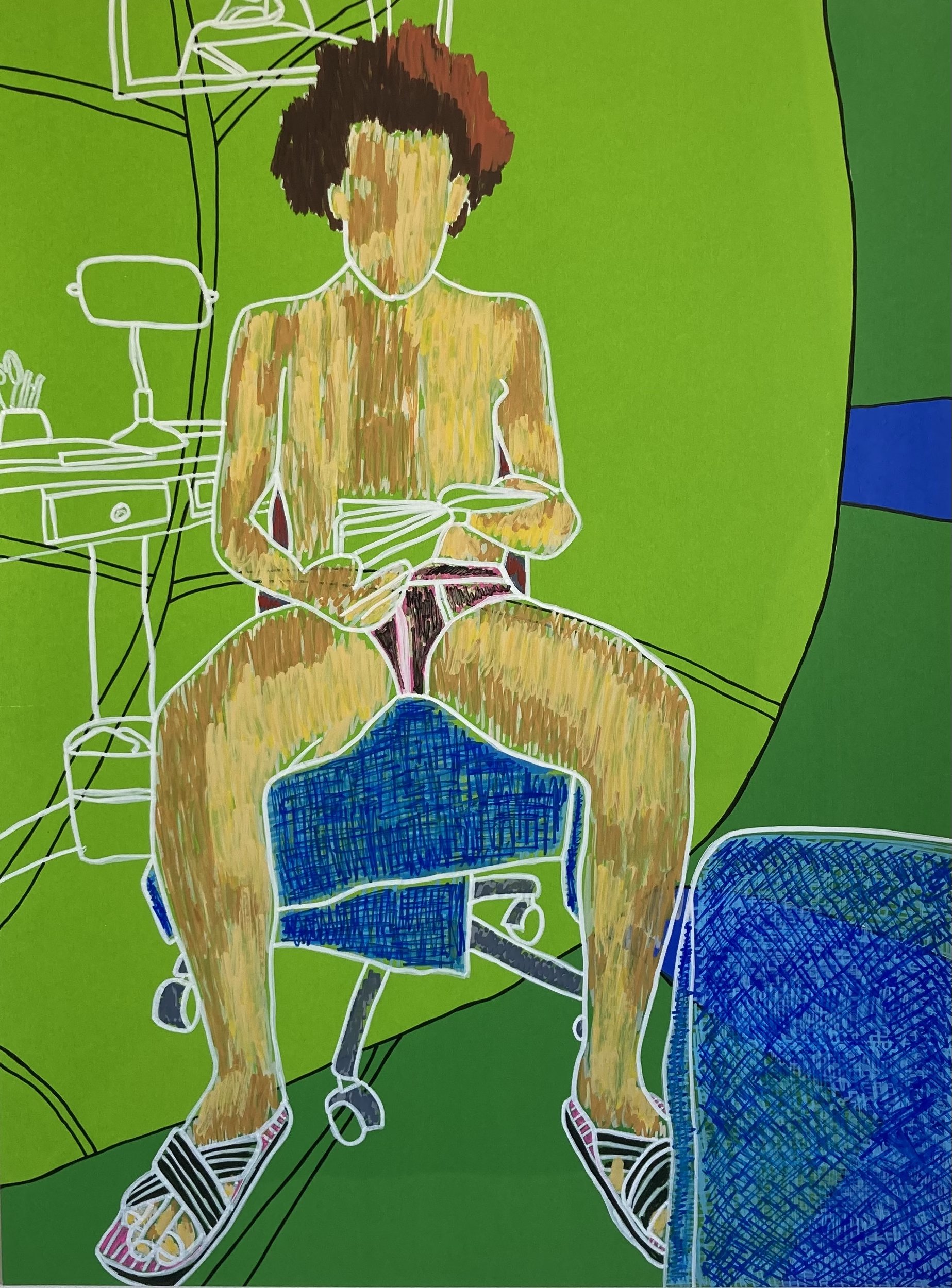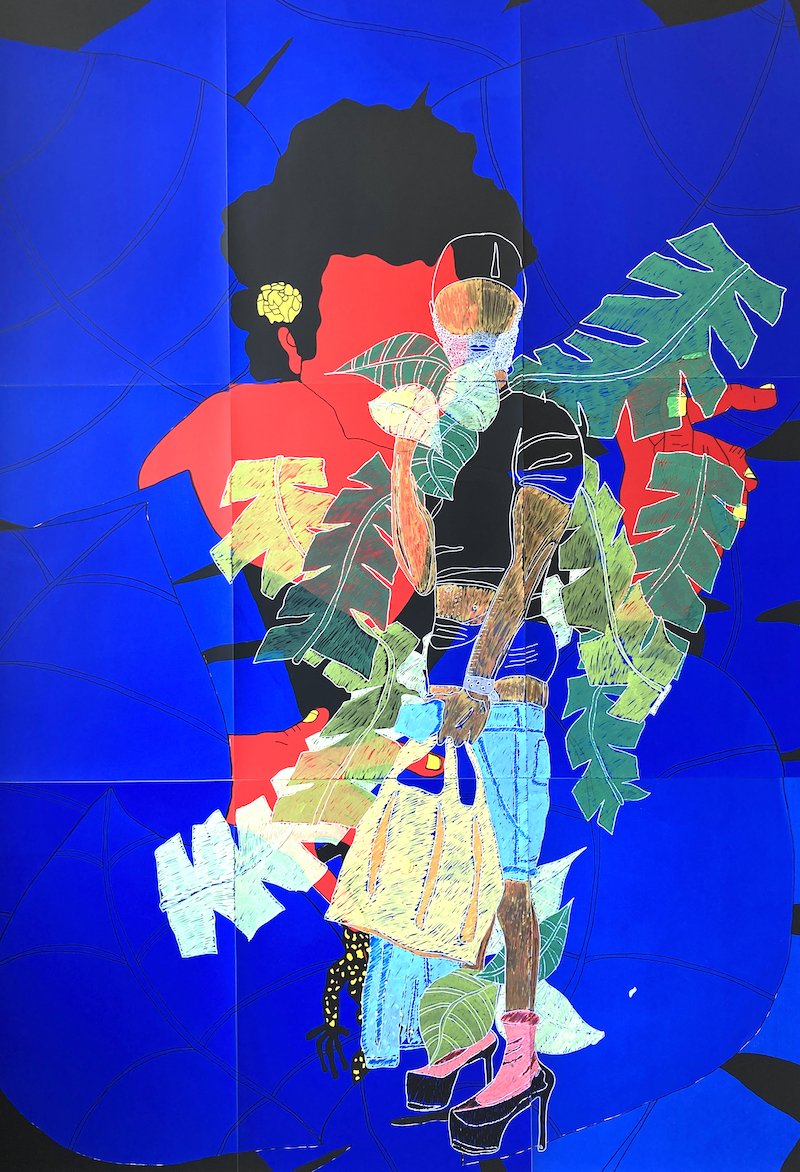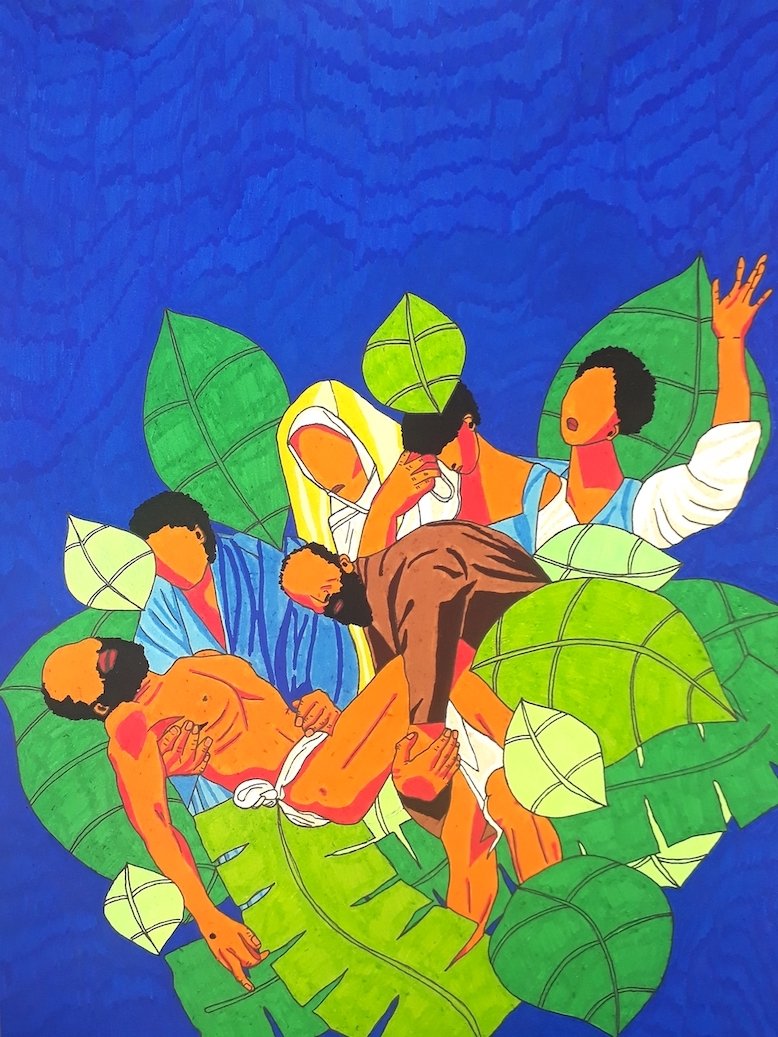Françoise Sémiramoth: "Color As A Territory"
Françoise Sémiramoth is a French-Créole artist, living in Marseilles, France but is originally from Guadeloupe, where she remains inspired by the vivid colors of the island. In some of her paintings, Sémiramoth borrows the basic forms from Caravaggio's work, using her own bright palette and infusing her images with the identity and history of the Guadeloupean people.
At Grandma’s, acrylic and silkscreen on paper, 29“ x 21.5“
Sémiramoth utilizes color as a tool to talk about the history of her native island of Guadeloupe, as well as her own history. In this painting, Sémiramoth captures a tender moment between her aunt and her little cousin. Her cousin cares for his grandmother’s feet (Françoise’s aunt) after she has worked in the garden.
About Dora, acrylic and silkscreen on paper, 87.5“ x 65.25“
In 2022, Sémiramoth was an Artist in Residence at La Maison Dora Maar (The Dora Maar House) in France. Dora Maar was a famous French photographer, also known for her romantic relationship with Pablo Picasso. Inspired by her time at the residency, Sémiramoth created this piece as a tribute to Dora Maar, reimagined through the lens of Guadeloupe and with reference to Boticelli’s Three Graces.
L.B., acrylic and silkscreen on paper, 13.25“ x 16“ framed
This painting is a depiction of a person that could be seen at Guadeloupe’s Carnival celebration, which occurs January through February. Guadeloupe’s Carnival is a combination of a celebration of life and a remembrance for the struggles present on the island. Throughout history, there were riots and rebellions against slavery, inflation, the use of cancer-causing pesticides, and even COVID-19 vaccinations, as the French government often overlooked the needs and the conditions on the island.
So What?, acrylic and silkscreen on paper, 13.25“ x 16“ framed
Another Carnival figure is shown here, though this piece represents the LGBTQ+ community of Guadeloupe. The island is typically not accepting of the LGBTQ+ community, except during Carnival. During this time, all people are welcomed and celebrated in Carnival. This figure reappears in a larger painting , which shares the title So What?.
FD/FS, acrylic and silkscreen on paper, 13.25“ x 16“ framed
FD/FS are the initials of the artist and one of her friends, whose name also happens to be Françoise. The pair have connected over Sémiramoth’s paintings many times and have worked together on art projects and writings.
Caravage Créole, Version 1, serigraph print on paper, ed. 3/15, 90.75“ x 68.25“ framed
Caravage Créole is the first of Sémiramoth’s paintings to be translated into a serigraph. The imagery comes from her study of Caravaggio’s paintings, having borrowed the composition from Boy Bitten by a Lizard and translating it into her own vivid colors and simplified shapes. Sémiramoth made three versions of Caravage Créole in different colors. The first version was an edition of 15, the second an edition of 10, and the third an edition of 5. Many of Sémiramoth’s paintings are directly connected to this piece, as they were painted on top of silkscreen prints from the three versions of Caravage Créole. If you look closely, you can identify which of the 9 panels serves as the background of each painting.
Somewhere, acrylic and silkscreen on paper, 13.25“ x 16“ framed
Sémiramoth has woven her family’s history into the narrative of this piece. Her mother and father first came to Guadeloupe by boat, imagining what that might have looked like in this painting. Sémiramoth also says that the two figures pictured are intended to be vague, so that they could represent any two people. “Everyone is from somewhere and is going somewhere,” she says.
Mum & Daughter, acrylic and silkscreen on paper, 13.25“ x 16“ framed
This painting was created in reference to an actual photograph of Sémiramoth and her mother arriving in France, from Guadeloupe. The photo was taken by a street photographer, who then offered them the picture.
8000 km, acrylic and silkscreen on paper, 13.25“ x 16“ framed
The man here is Sémiramoth’s father, who was also a painter. Sémiramoth says that her father only painted Guadeloupe, using the bright colors and tropical patterns reminiscent of the island, even as he lived away from Guadeloupe, in the French countryside. Sémiramoth says that she was “born with color” because of her father’s paintings.
Chevalier de Saint-Georges, acrylic and silkscreen on paper, 13.25“ x 16“ framed
Chevalier de Saint-Georges, also known as “The Black Mozart,” was a French Creole violinist and composer born in Guadeloupe. His father was a white plantation owner and his mother a slave. This painting depicts Distillerie Bologne in Guadeloupe, which exists on the land that used to be Saint-Georges’ father’s plantation. In the painting, you can identify a slave bell and a small shack that would have been part of the slaves’ quarters. Sémiramoth has added two figures to the scene: another Carnival attendee on the left and a representation of Chevalier de Saint-Georges on the right.
History of Guadeloupe, acrylic and silkscreen on paper, 87.5“ x 65.25“
Sémiramoth has gathered important figures to Guadeloupe in this painting. The left-most figure represents the Amerindian people, the natives of Guadeloupe. He holds a sword brought to the island by the conquistadors. Beside him, a Carnival woman in costume marches to the sound of traditional “ka” drumming. Towards the right side of the painting, a colonizer dressed in all white has his back to the people of Guadeloupe. A protestor from the 1967 Guadeloupean riots holds up a picture of a man that was murdered by French police, during a workers’ strike. The red car towards the center of the piece also refers to the damages caused during the riots.
In the Guest Room, acrylic and silkscreen on paper, 29“ x 21.5“
In this piece, Sémiramoth investigates how to achieve a sense of depth with minimalism. French artist, Henri Matisse experimented with the same concept, using bright colors and stylized, simplified shapes to depict three-dimensional forms. The image is a scene from Sémiramoth’s home, of her husband as he reads.
So What?, acrylic and silkscreen on paper, 87.5“ x 65.25“
The background of this large painting is one of the serigraphs from Caravage Créole, Version 3. The figure painted overtop occupies a smaller painting in the exhibition, dedicated to the LGBTQ+ community in Guadeloupe, who are only free to express themselves fully during the Carnival festivities.
The 80’s, acrylic and silkscreen on paper, 29“ x 21.5“
Sémiramoth’s aunt is shown here again, originally captured in the painting At Grandma’s. She holds balloons celebrating her 80th birthday, a milestone that the family was not sure she would reach due to her battle with cancer. Sémiramoth’s aunt works the land, growing bananas, avocados, and vegetables. Years ago, a dangerous cancer-causing pesticide was being used on the island, despite being banned in France. Several members of Sémiramoth’s family have been affected by this.
Harvesting 2, acrylic and silkscreen on paper, 29“ x 21.5“
Harvesting, acrylic and silkscreen on paper, 29“ x 21.5“
These two paintings show Sémiramoth and her family as they harvest vegetables from their land in Guadeloupe. Sémiramoth is seen holding a water bottle, working alongside her relatives.
Françoise Sémiramoth has borrowed compositions from Italian Renaissance painter, Michelangelo Merisi da Caravaggio for each of these paintings. She uses bold colors and simplified shapes to translate the classic compositions into her own style, always using the tropical leaf as a letimotif for the island of Guadeloupe. This series of work began with Sémiramoth’s research into color, seeking to create darkness and contrast without using the shadow and chiaroscuro that is characteristic of Caravaggio’s work. This work not only demonstrates her love for painting, but marks the beginning of the body of work exhibited in Color As A Territory.
Sémiramoth finds a certain irony in her work, comparing the beauty and richness of Caravaggio’s time in 16th century Italy, and the horrors of colonization and slavery happening in Guadeloupe, during the same period in history. For Sémiramoth, working in bright colors allows the viewer to approach her paintings for their beauty, thus opening up an opportunity to share the brutal and unrecognized history of Guadeloupe.
By the Name of 3, acrylic and silkscreen on paper, 29“ x 21.5“
Caravaggio’s The Crucifixion of St. Peter
Michelangelo Merisi da Caravaggio #5 (MMDC5), Version 2, acrylic and silkscreen on paper, 9.5“ x 12.5“
Caravaggio’s The Cardsharps
Michelangelo Merisi da Caravaggio #15 (MMDC15), Version 2, acrylic and silkscreen on paper, 12.5“ x 9.5“
Caravaggio’s Madonna of the Rosary
Michelangelo Merisi da Caravaggio #10 (MMDC10), Version 2, acrylic and silkscreen on paper, 12.5“ x 9.5“
Caravaggio’s The Conversion of St. Paul
Michelangelo Merisi da Caravaggio #1 (MMDC1), Version 3, acrylic and silkscreen on paper, 12.5“ x 9.5“
Caravaggio’s Boy Bitten by a Lizard
Michelangelo Merisi da Caravaggio #14 (MMDC14), Version 2, acrylic and silkscreen on paper, 12.5“ x 9.5“
Caravaggio’s Madonna and Child with St. Anne
Bacchus, acrylic and silkscreen on paper, 87.5“ x 65.25“
Caravaggio’s Bacchus
Michelangelo Merisi da Caravaggio #7 (MMDC7), acrylic on paper, 12.5“ x 9.5“
Caravaggio’s The Crucifixion of St. Peter
Michelangelo Merisi da Caravaggio #8 (MMDC8), acrylic on paper, 12.5“ x 9.5“
Caravaggio’s David with the Head of Goliath
Michelangelo Merisi da Caravaggio #4 (MMDC4), acrylic on paper, 9.5“ x 12.5“
Caravaggio’s St. Gerome Writing
Michelangelo Merisi da Caravaggio #12 (MMDC12), acrylic on paper, 12.5“ x 9.5“
Caravaggio’s The Entombment of Christ
Michelangelo Merisi da Caravaggio #11 (MMDC11), acrylic on paper, 9.5“ x 12.5“
Caravaggio’s The Incredulity of St. Thomas
Michelangelo Merisi da Caravaggio #13 (MMDC13), acrylic on paper, 9.5“ x 12.5“
Caravaggio’s The Crowning with Thorns

